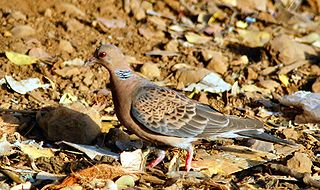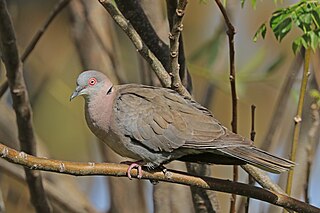
Columbidae is a bird family consisting of doves and pigeons. It is the only family in the order Columbiformes. These are stout-bodied birds with short necks and short slender bills that in some species feature fleshy ceres. They primarily feed on plants, and can be taxonomically divided amongst granivores, that feed mostly on the ground on seeds, and frugivores, that feed mostly on fruits, from branches. The family occurs worldwide, often in close proximity with humans, but the greatest variety is in the Indomalayan and Australasian realms.

The European turtle dove is a member of the bird family Columbidae, the doves and pigeons. It breeds over a wide area of the south western Palearctic including north Africa but migrates to northern sub-Saharan Africa to winter.

The Eurasian collared dove, collared dove or Turkish dove is a dove species native to Europe and Asia; it was introduced to Japan, North America and islands in the Caribbean.

The Oriental turtle dove or rufous turtle dove is a member of the bird family Columbidae. The species has a wide native distribution range from Central Asia east across Asia to Japan. The populations show variations in the patterning of plumage and have been designated into at least six named subspecies. Populations in the higher latitudes tend to migrate south in winter, while those closer to the tropics are sedentary. Vagrants have been recorded in North America. The species is predominantly granivorous and forages on the ground.

The Barbary dove, ringed turtle dove, ringneck dove, ring-necked turtle dove, or ring dove is a domestic member of the dove and pigeon family (Columbidae).

The bird genus Columba comprises a group of medium to large pigeons. The terms "dove" and "pigeon" are used indiscriminately for smaller and larger Columbidae, respectively. Columba species – at least those of Columba sensu stricto – are generally termed "pigeons", and in many cases wood-pigeons. The rock dove has given rise to the majority of domesticated pigeon breeds, such as the racing pigeon and the fantail pigeon, some of which have become feral. Meanwhile, "wood pigeon" by itself usually means the common wood pigeon.

The spotted dove or eastern spotted dove is a small and somewhat long-tailed pigeon that is a common resident breeding bird across its native range on the Indian subcontinent and in Southeast Asia. The species has been introduced to many parts of the world and feral populations have become established.

The laughing dove is a small pigeon that is a resident breeder in Africa, the Middle East, South Asia, and Western Australia where it has established itself in the wild after being released from Perth Zoo in 1898. This small long-tailed dove is found in dry scrub and semi-desert habitats where pairs can often be seen feeding on the ground. It is closely related to the spotted dove which is distinguished by a white and black chequered necklace. Other names include laughing turtle dove, palm dove and Senegal dove while in Asia the name little brown dove is often used.

The red-eyed dove is a dove that is widespread and common in Sub-Saharan Africa. It has been listed as Least Concern on the IUCN Red List since 2004.

The mourning collared dove or African mourning dove is a dove which is a widespread resident breeding bird in Africa south of the Sahara. Despite its name, it is not related to the North American mourning dove. This species is common or abundant near water. They often mingle peacefully with other doves.

The vinaceous dove is a bird species in the pigeon family Columbidae that widely resident across the Sahel and Sudan (region).

Streptopelia is a genus of birds in the pigeon and dove family Columbidae. These are mainly slim, small to medium-sized species. The upperparts tend to be pale brown and the underparts are often a shade of pink. Many have a characteristic black-and-white patch on the neck and monotonous cooing songs.

The Barbary falcon is a medium-sized falcon about the size of a crow. This bird of prey is mainly resident. It ranges from the Canary Islands eastwards across some parts of North Africa, the Middle East and Central Asia.

The ring-necked dove, also known as the Cape turtle dove or half-collared dove, is a widespread and often abundant dove species in East and southern Africa. It is a mostly sedentary bird, found in a variety of open habitats. Within range, its penetrating and rhythmic, three-syllabled crooning is a familiar sound at any time of the year. Its name is derived from the semi-collar of black feathers on the lower nape, a feature shared with a number of Streptopelia species. Like all doves, they depend on surface water. They congregate in large flocks at waterholes in dry regions to drink and bathe.

The pink pigeon is a species of pigeon in the family Columbidae endemic to Mauritius. The pink pigeon nearly became extinct in the 1970s and the 1990s and is still very rare. It is the only Mascarene pigeon that has not become extinct. It was on the brink of extinction in 1991 when only 10 individuals remained, but its numbers have increased due to the efforts of the Durrell Wildlife Conservation Trust since 1977. While the population remains at below 500 birds as of 2011, the IUCN downlisted the species from Critically endangered to Endangered on the IUCN Red List in 2000, and then downlisted it again to Vulnerable in 2018.

The red collared dove, also known as the red turtle dove, is a small pigeon which is a resident breeding bird in the tropics of Asia. The male has a blue-grey head and a red-brown body. The female is much plainer, with pale brown plumage similar to that of the larger Eurasian collared dove.
Ring dove is an alternative name for the Barbary dove. It may also refer to:

The Malagasy turtle dove or Madagascar turtle dove is a bird species in the pigeon and dove family, Columbidae. It is found in Mauritian-Indian Ocean Territory, the Comoros, Madagascar, Mauritius, Mayotte, Réunion, and the Seychelles.

The Sunda collared dove, sometimes referred to as the island collared dove, Javanese turtle dove, Javanese collared dove, or Indonesian collared dove, is a species of bird in the family Columbidae. Sometimes confused with the Eurasian collared dove which is very similar in appearance, the Sunda collared dove is a small to medium-sized bird, native to the tropical and subtropical islands of Indonesia.

The Philippine collared dove is a species of bird in the family Columbidae. It was formerly considered a subspecies of the island collared dove.





















